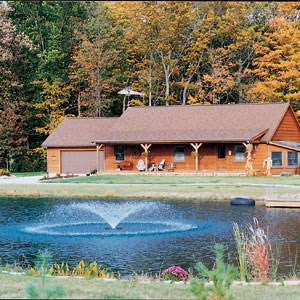Articles and Press
Pond Dynamics and Autumn
As the seasons change, so do pond and lake dynamics. The two climatic factors which have the greatest impact on seasonal variations in water quality are temperature and light - and biological activity in the pond is directly tied to these two factors. A third factor, nutrient loading, should also be considered. As such, a thorough understanding of these seasonal changes will help you guide you to timely solutions.
Temperature
Temperature has significant impact on both plant and animal life, simple and complex, in the aquatic ecosystem. Since few forms of animal life in the pond are warm blooded, the effects of lower temperatures are significant. Fish and other cold blooded species slow and will become dormant when temperatures drop low enough. As temperatures drop, so do the metabolic rates of bacteria and protozoa, Mother Nature's "garbage disposals" so to speak. Digestion rates are tied to water temperature, the lower the temperature the slower the rates of decomposition. See Chart at the right for simple rule of thumb.
To achieve similar decomposition rates the bacteria population must be increased considerably in cold water. Plant life as well, is significantly affected by colder water and we see much slower growth rates in the Autumn season. The good news is colder water has the capacity to hold more dissolved oxygen, in fact more than 40% more.

Light
Light plays a significant role in the process of photosynthesis. As light decreases, so does the photosynthetic rates of plants. They are growing slower or not at all! Bottom rooted weeds and algae miraculously seem more manageable or disappear.

Nutrient Loading
Nutrient loading remains constant in the Fall and is not effected by the changing of seasons. Non-source pollutants and fertilizers will continue to leach or run-off into the lakes. Leaves, water fowl and fish waste, dead or dying aquatic plants including algae sink to the bottom. The end result ... as bacterial digestion rates slow and approach net zero, the nutrient levels of the pond continue to increase. This places the pond or lake out of balance, adding to the sludge bed and the "aquatic compost" pile at the pond or lake bottom and its most assuredly . Its guaranteed to give the lake manager bigger headaches next year. Because people often tend to deal with symptoms of poor water quality (algae, odors, etc...) as opposed to the causes, focus on water quality management fades when the symptoms disappear. A year round aeration and water quality management program will create a healthy ecosystem allowing the natural biological activity to continue throughout the seasons - leaving you with clean, healthy ponds in the seasons ahead.Ready to learn more?
Find out how an energy efficient aeration system from Otterbine can provide natural and effective water quality solutions. Talk to us about your commercial needs.
